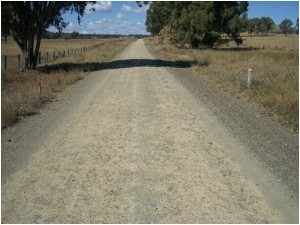ARRB Group: Local Road Deterioration Models
 This project, a collaboration of more than 230 road agencies, has developed the first national Australian local road deterioration models. The models were derived from analysing the findings of a long term monitoring strategy covering over 500 sealed and 100 unsealed local road sites of various traffic and climatic environments across Australia.
This project, a collaboration of more than 230 road agencies, has developed the first national Australian local road deterioration models. The models were derived from analysing the findings of a long term monitoring strategy covering over 500 sealed and 100 unsealed local road sites of various traffic and climatic environments across Australia.
For the first time, asset managers have access to a range of evidence based deterioration models to assist in making decisions about maintenance program for local roads.
The extent of scientific rigour applied to the data collection and analysis has enabled these models to be unique, rigorous and robust.
Project objectives
Effective optimisation and prioritisation of all maintenance works (advanced asset management) rely upon soundly based asset management systems (AMS) and the models within them. Most asset management systems in Australia were based on internationally derived deterioration models adapted to suit local conditions but with limited success. As a result, asset managers have been shifting away from empirical and data based advanced AMS and relied increasingly on experienced practitioners.
Hence, this project was established to develop Australian evidence based road deterioration models for sealed (sprayed seal and asphalt surfacing) and unsealed local road types which would be suitable for incorporation into an existing AMS. This was to encourage and support asset managers to move towards using advanced asset management with systems and models tailored to their local conditions and practices.
Project outcomes
The deterioration models for:
- unsealed roads included roughness deterioration, gravel loss and transverse shape loss to the pavement
- sealed roads included surface cracking, rutting, structural strength and roughness.
To better assist Councils with their application, the models have been incorporated into a MS Excel tool. The models have since been implemented by a number of Councils for maintenance planning, e.g. Moorabool Shire in Victoria. The successes seen so far have led to a plan for wide implementation across local government road authorities in Western Australia through the ROMAN II AMS scheduled for 2012.
The models when implemented ensure AMS is more effective and efficient. Research has shown that implementing an effective AMS can result in more annual maintenance savings of up to 30% through improved management and judicious allocation of resources.
Innovative features of the project
A local road deterioration study of this size and scope covering such a wide range of conditions over an extended period has not been undertaken before in Australia or overseas.
Selected sealed local road sites from the participating councils and other organisations, which represented a wide range of communities across Australia, were monitored over five years, while unsealed road sites were monitored over one year.
Due to budget constraints, the monitoring period in terms of a pavement life was shorter than desired i.e. three measurements in five years. Therefore, a large number of road sites (600) was used to compensate for any potential discrepancies.
Distinguishing features of the project
The project governance structure enabled 236 separate organisations (local and state government authorities, and others) to participate in the study. Each organisation provided traffic and inventory data for the sites, and financially supported the data collection and the analysis exercise. The individual site data was then consolidated into a common database from which the deterioration models were derived.
The study commenced in 2000 and was first delivered in regional instalments, with the final completion of the national study in May 2011. This required a sustained team effort from the ARRB project team and the participating organisations.
Barriers overcome to achieve success
Due to the long duration of the study, the maintenance of enthusiasm, retention of staff and maintaining ongoing support and participation was a continual challenge. Regular contact and a continuous focus on the benefits and value of this work with the participating organisations was paramount for this project. Maintaining data validity was achieved through full documentation and adherence to ARRB monitoring protocols, to ensure consistency in data collection and reporting.
Costs/ benefits associated with the project
Whilst the consolidated cost of the study was approximately $4.5 million, each organisation only contributed a relatively small amount of around $1,500 per year per site over the five year monitoring period. In pooling the funds and associated work into a single significant research program, all participants effectively benefited from the $4.5 million national research program, delivered by highly experienced research engineers with rigour and high quality standards for a minimal outlay. From the cost benefit point of view, $4.5 million is a small investment in an estimated annual expenditure of $1.6 billion on local road maintenance.
As mentioned, the introduction of an effective AMS can potentially save annual maintenance expenditure by up to 30% through improved management and more efficient allocation of resources.
Assuming a more conservative annual saving of 5%, the dollars annually saved across Australia are an estimated $80 million. Additional establishment costs would initially be borne by each local government authority purchasing and adapting at AMS to their specific requirements. However, the total expenditure would still be well below the estimated annual savings.
Download full details of ARRB Group Local Road Deterioration Models



 Posted under:
Posted under: